Vintage Style Clawfoot Bathtubs & Soaking Tubs
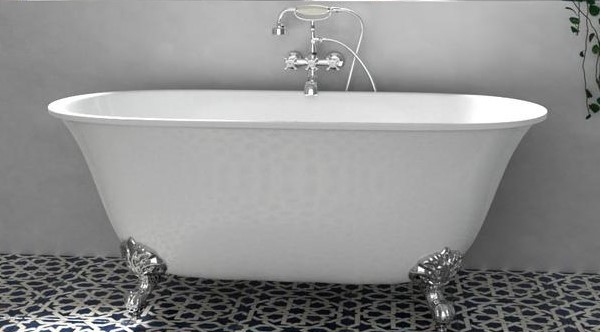
Even if referred to as 'vintage,' a clawfoot tub will never go out of style. These iconic soaking tubs add a timeless elegance and romantic vibe that fits seamlessly into almost any bathroom decor, from Victorian traditional to industrial modern. Explore our extensive collection of freestanding bathtubs with feet, available in durable cast iron, lightweight acrylic, and stunning copper. Whether you prefer a classic Roll Top with ball-and-claw feet or a Double Slipper on a contemporary cradle, you will find the perfect centerpiece for your home here.
Shop Clawfoot by Tub Length:
- Small Clawfoot Tubs (Under 5')
- Standard 5-Foot Clawfoot Tubs (60" - 63")
- 5.5' Clawfoot Bathtubs (65" - 68")
- Large Luxury Clawfoot Tubs (69"+)
History & Design: The Modern Clawfoot Bathtub
In the early 1880s cast iron clawfoot tubs had a painted interior. This paint would flake and peel over time. In 1880 David Buick developed a process to bond porcelain enamel to cast iron. The enamel creates a smooth surface that is easy to clean and prevents the spread of bacteria. This was the start of the modern clawfoot bathtub. In their beginning these tubs were not very luxurious or ornate. In fact, in 1883 John Michael Kohler added four decorative feet to the bottom of an enamel-covered, cast-iron horse trough and advertised it as "a horse trough/hog scalder . . . when furnished with four legs will serve as a bathtub." These cast iron enamel tubs became very popular, and designs changed to be more ornate. Learn more about Clawfoot Tub Design →
32" - 59" Clawfoot Soaking Bathtub
Tubs are listed by size: first by length, then by width, then by height - smallest to largest
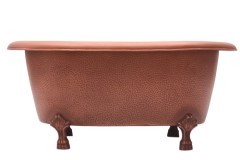
Picasso
32" x 18" x 14"
Copper Clawfoot
Double Roll Top
Center Drain
Claw Feet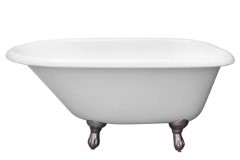
Addison
48" x 30" x 21"
Cast Iron Clawfoot
Roll Top Tub
End Drain
Ball & Claw Feet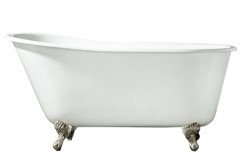
Gareth
53" x 28" x 29"
Cast Iron Clawfoot
Slipper Bathtub
End Drain
Ball & Claw Feet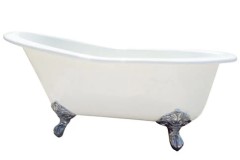
Gavin
54" x 30" x 32"
Cast Iron Clawfoot
Slipper Bathtub
End Drain
Imperial Feet-

Antonio
56 x 30" x 25"
Cast Iron Clawfoot
Roll Top Tub
End Drain
Ball & Claw Feet 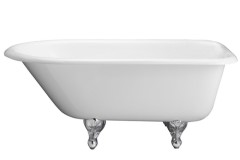
Aristo
56 x 30" x 25"
Cast Iron Clawfoot
Roll Top Tub
End Drain
Ball & Claw Feet
Giselle
57" x 30" x 30"
Cast Iron Clawfoot
Slipper Bathtub
End Drain
Imperial Feet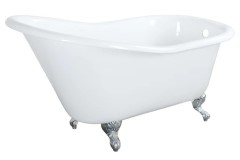
Grayson
57" x 30" x 30"
Cast Iron Clawfoot
Slipper Bathtub
End Drain
Ball & Claw Feet
Ballard
57" x 31" x 23"
Cast Iron Clawfoot
Roll Top Tub
End Drain
Ball & Claw Feet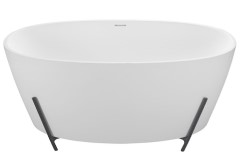
Elena 245C
58" x 32" x 28"
Solid Surface
Double
Center Drain
Steel Cradle
5 Foot Clawfoot Tubs | 60" - 63"
-
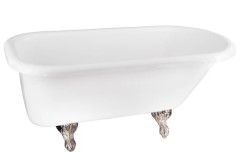
Anthea
60" x 30" x 25"
Acrylic Clawfoot
Roll Top Tub
End Drain
Ball & Claw Feet 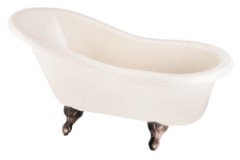
Fillmore
60" x 30" x 32"
Acrylic Clawfoot
Slipper Bathtub
End Drain
Ball & Claw Feet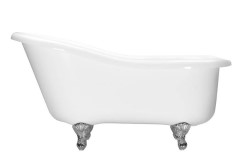
Grace 6032F
60" x 32" x 30"
Acrylic Clawfoot
Slipper Bathtub
End Drain
Claw & Ball Feet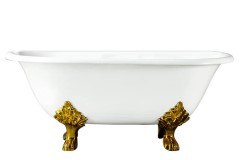
Dawson
61" x 30" x 24"
Cast Iron Clawfoot
Double Bathtub
Center Drain
Lion Paw Feet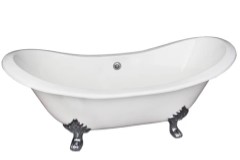
Macon
61" x 30" x 29"
Cast Iron Clawfoot
Double Slipper
Center Drain
Lion Paw Feet
Halifax
61" x 30" x 29"
Cast Iron Clawfoot
Slipper Bathtub
End Drain
Imperial Feet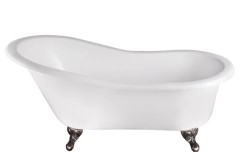
Griffin
61" x 30" x 31"
Cast Iron Clawfoot
Slipper Bathtub
End Drain
Ball & Claw Feet-

Bartlett
61" x 31" x 23"
Cast Iron Clawfoot
Roll Top Tub
End Drain
Ball & Claw Feet -

Beecher
61" x 31" x 23"
Cast Iron Clawfoot
Roll Top Tub
End Drain
Ball & Claw Feet 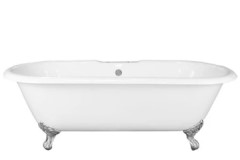
Columbus
61" x 31" x 24"
Cast Iron Clawfoot
Double Roll Top
Center Drain
Imperial Feet
Clawfoot Tub Styles: Roll Top, Slipper & Double Ended:
No matter the tub material, a clawfoot tub will fall in one of these four styles:
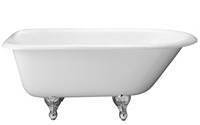
Roll Top
This clawfoot is designed for one bather. The drain end is flat and the backrest rounded - elongated "D" shape. Traditionally called a roll top since in most cases the rim of the tub is curved - rolls from the inside of the tub to the outside. We have included some more modern styles that have a flat rim.
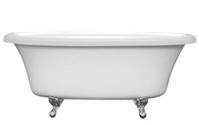
Double Ended or Double Roll Top
Designed for two, this bath is designed with a center drain and two slanting backrests. The rim is most likely to be round with a flat area above the drain for the tub filler. We have also included some flat rim designs.
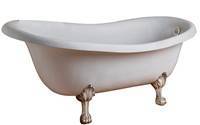
Slipper
A raise backrest elegantly slopes for comfort while soaking. The drain rim sits lower often with the possibility of clawfoot faucets installed above the drain.
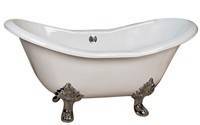
Double Slipper
A double slipper bath offers the most elegant profile with two raised backrests. Designed for 2, these clawfoot tubs are designed with a center drain.
Clawfoot Tub Feet Styles: Ball & Claw, Lion Paw & Imperial
Why Claw Feet?
Clawfoot design is thought to be inspired by Chinese designs of a dragon's claw clutching a pearl. It became popular with the English in the 1800s when it was used to add design detail to furniture. The foot became lion's paw or eagle's talon grasping a ball. In the late 19th century this design was used to solve a problem, the elevated the tub to keep the floor dry, reducing the occurrence of rot and mold.
The style of feet will vary between the tubs but here are a few of the styles offered:
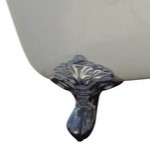
Ball and Claw Foot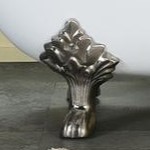
Lion Paw Foot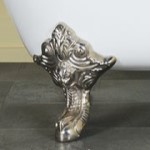
Imperial Foot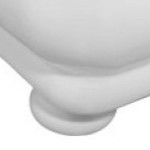
Bun Feet
The choice of materials has changed over time with the additions of acrylic and solid surface. Many have moved away from the cast iron since they are much heavier and harder to install than their acrylic counterparts. The solid surface clawfoot tubs are heavy like cast iron but they have a more modern vibe with their matte finish. Did you know that copper tubs have natural anti-bacterial properties?
Why buy your clawfoot tub from Tubz.com?
We are not just order takers in a call center. We are a small team that takes pride in our personal customer service and the expert knowledge we have accumulated in our 25+ years of experience. As you browse through these tubs and see list prices, these are not our sale prices. Most of the time our prices are too low to show (from a manufacturer's position). Email or call us to receive the same prices contractors do, up to 40% off! Plus the majority of our tubs are made right here in the US, and come with strong warranties. Let us help you find the bath of your dreams at a great sale price and with free shipping!
Helpful Bathtub Information:
• How to Choose a Freestanding Bathtub Buying Guide
• Contact the Tubz.com Bathtub Experts

